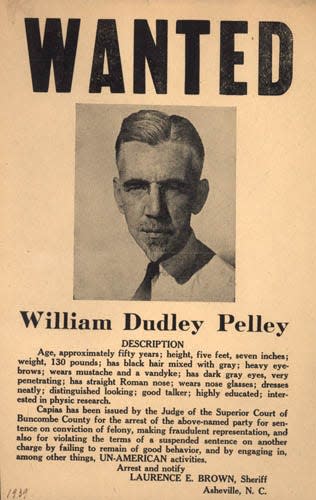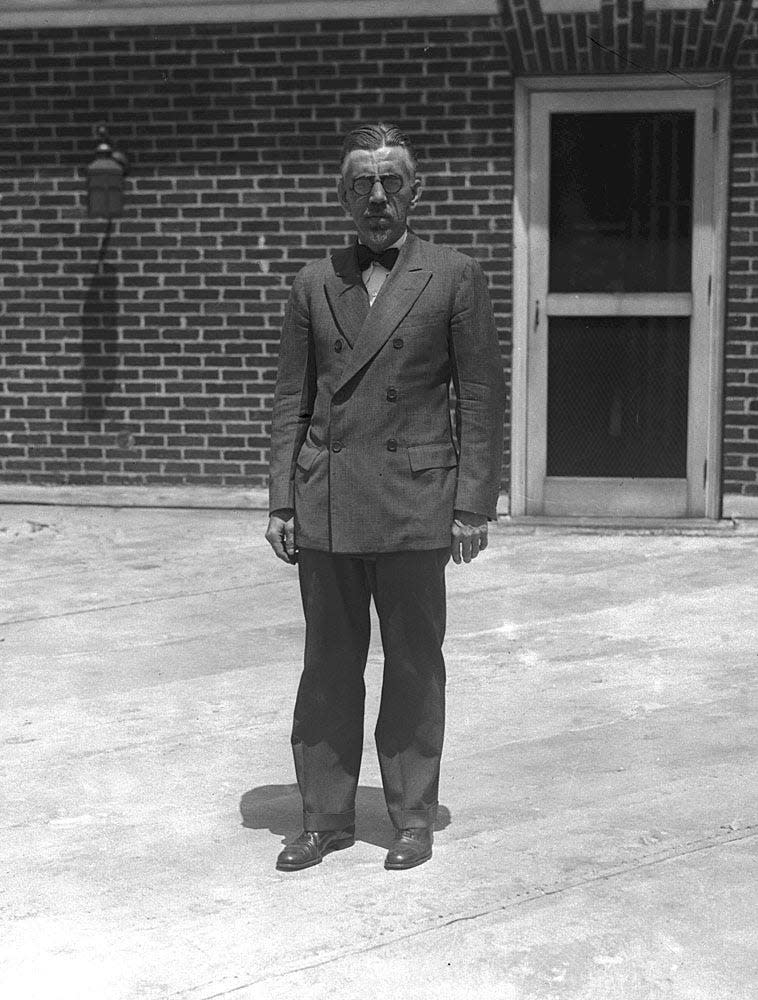Answer Man: Who was Asheville man who led national '30s fascist movement?
- Oops!Something went wrong.Please try again later.

This installment of Answer Man deals with a strange time in United States history when shortly before World War II fascism gained a serious foothold in the country. Oddly, one of the movement's headquarters was in Asheville. The story offers some striking parallels with today, including militants plotting the overthrow of the government and a leader accused of sedition, a rarely charged political crime, but one used recently against organizers of the Jan. 6, 2021, Capitol insurrection.
Have a question for Answer Man or Answer Woman? Email Executive Editor Karen Chávez at KChavez@citizentimes.com and your question could appear in an upcoming column.
Question: As a Haywood County native born a considerable number of years ago, I had to admit that I had never heard of William Dudley Pelley, winner of two O. Henry Awards. He lived in Asheville during the 1930s. He was notorious for being the founder and leader of the Silver Legion of America, a fascist paramilitary league. Could you shed some light on Mr. Pelley’s life and his time here in Asheville? Where was his office/headquarters of the Silver Legion? Was he involved in local civic affairs? Did he have followers here in Western North Carolina?
Answer: In the more than 20 years I've lived here, I remember reading briefly about the "Silver Shirts" but not hearing much else about the movement. Considering Asheville's liberal politics, it's not surprising people weren't eager to memorialize Pelley.
Still, I found several local and national scholars who took an interest in Pelley's concept of a millennial armageddon for which white believers should arm themselves and prepare to battle the forces of darkness, including Jews and communists. That was bolstered by Pelley's own form of pseudo-religious mysticism. Among those writing about Pelley were Rob Neufeld, the now-deceased historian and Citizen Times contributor as well as Jon Elliston, Mountain Xpress writer, author and historian. One of the most recent pieces I found, from 2015, was by former Syracuse University history professor David Lobb.
More:WNC Jan. 6 rioter gets one of harshest sentences in US Capitol attack convictions
More:How will Oath Keepers trial affect candidate for NC House who was a member of the group?
Lobb said that Pelley, born in Lynn, Massachusetts, was the only son a Methodist minister who relocated his family regularly. That gave Pelley little time to establish friendships or complete a formal education − though exposure to his father's version of Protestantism was constant. "It is clear that Pelley would have the necessary ideological tools to make religion, but more importantly, millennial Christianity part of the movement he would later start," Lobb wrote.
As an adult, Pelley worked as a reporter for the Saturday Evening Post in World War I in Russia, developing an anti-communist sentiment. Back in the U.S. he wrote screenplays in Hollywood, including for Lon Chaney films, and got involved with various business ventures. But financially things did not go well and in 1921 his wife left him. Several years later he claimed to have a near-death experience in which he spoke to God and Jesus about a new type of religion, calling it "Liberation Doctrine." Pelley wrote about the experience in the story "Seven Minutes in Eternity" published in American Magazine and widely read at the time of heightened interest in mysticism.
More:Answer Woman: Are restaurants providing heated outdoor patios during flu season?
More:Answer Woman: Is Buncombe County the next frontier for pickleball play? Fletcher?
Pelley's other writings earned him two O. Henry Awards: a second prize for a short story in 1920 and another selected for the category of Best Short story in 1930. Soured on Hollywood and blaming Jews there for his failures, Pelley moved to the Asheville area in 1930. (I don't know if it was a coincidence that he moved to the city where O. Henry, the famous writer, is buried and where a street in front of the Citizen Times bears O. Henry's name.)
In the 1930s Pelley went full tilt into his new ideology, starting Galahad Press in Biltmore Village where he pumped out publications promoting white supremacy and criticizing Jews and President Franklin Roosevelt's New Deal. Adolf Hitler's 1933 rise to power backed by the paramilitary Brown Shirts inspired Pelley to found the Silver Legion, with chapters of like-minded militants across the country whose members wore silver shirts with an "L" for Liberation. The Silver Shirts were among several American pro-Nazi groups.
More:The Gift of the Magi
More:Who's buried in Riverside Cemetery? See the list of notables

Elliston, the former Mountain Xpress writer, said Pelley trumpeted in his publications Liberation and Pelley's Silver Shirt Weekly his plan for addressing "the Jewish problem" − "a plan that bore no small resemblance to Hitler’s."
"The Silver Shirts, Pelley pledged, would spearhead a new ‘Christian Commonwealth’ in the United States, which would register all Jews in a national census, then systematically reduce their role in business, government and cultural affairs, ultimately confining all Jews within one city in each state," Elliston said.
In 1934, at the age of 44, Pelley remarried to Minnie Helen Hausmann of Asheville, according to Buncombe County Register of Deeds records. While Pelley undoubtedly had some support in Western North Carolina, it appears most of his up to 20,000 adherents were in the chapters scattered around the nation. The same year he was married he faced bankruptcy of his press, according to an edition of the Jewish Daily Bulletin. Pelley was able to continue his operation, but I could find no explanation as to how. Some sources talked of wealthy backers from around the country often stepping in to save him.
In the mid-1930s Pelley and the Silver Shirts were looking to move beyond rhetoric. In 1935 he founded the Christian Party and ran for president against Roosevelt in 1936, garnering fewer than 2,000 votes.
In 1935, according to government officials and informants in the movement, the Silver Shirts had gathered in San Diego and were drilling in military fashion. They had acquired weapons from a Navy depot, the informant said. A siege was planned and "suspected Jewish officials would be 'liquidated,'" Lobb, the Syracuse historian wrote. But the siege never materialized.
Meanwhile, government scrutiny of Pelley intensified. Supporters' pro-Nazi stances and appearance became less socially acceptable as World War II neared, Lobb said. In Asheville, Neufeld, the long-time Citizen Times contributor, wrote of how in 1939 a group of high school students vandalized the former Biltmore-Oteen Bank on Lodge Street that had just been purchased by Pelley, according to the register of deeds office.
The students were at first admonished by school officials. But that changed after national media learned of the incident and praise followed, Neufeld said.
"The boys were treated as heroes and seated at a special table in the cafeteria," he wrote.
More:Answer Man: Status of Mark Meadows voter fraud probe? Where did Meadows vote in 2022?
More:Answer Man: Should Asheville police, Buncombe Sheriff's Office be combined?
The U.S. House Committee on Un-American Activities investigated Pelley and in 1940 federal marshals raided his Asheville headquarters, arresting followers and seizing his property.
He was subpoenaed by the House committee and in 1942 charged with insurrection and sedition for plans to overthrow the government. According to Lobb, he was not found guilty of the more serious sedition charge but was convicted on other charges and sentenced to 15 years in prison. He was released in 1950 and had one more Asheville-related experience: a conviction for securities fraud from his time in the city. Pelley was fined and sentenced to probation.
Pelley spent the rest of his life in Noblesville, Indiana, according to the North Carolina History Project, which said he developed an "elaborate religious philosophy called 'Soulcraft,' based on his belief in UFOs and extraterrestrials." He died June 30, 1965.
Pelley at the time of his death was "an agitator without a significant following," the New York Times said. Lobb, though, in 2015 had a more dire assessment − one that seemed to foreshadow events such as the Jan. 6 Capitol attack and the conviction of leaders of the Oath Keepers militia for sedition.
"It has been said that although Pelley died a forgotten man as the defendant in one of America’s rare sedition trials he had a great impact on people during the 1930s. It could also be argued that the Silver Shirts and William Pelley are still alive in the ideology of the extreme right," he said.
Joel Burgess has lived in WNC for more than 20 years, covering politics, government and other news. He's written award-winning stories on topics ranging from gerrymandering to police use of force. Got a tip? Contact Burgess at jburgess@citizentimes.com, 828-713-1095 or on Twitter @AVLreporter. Please help support this type of journalism with a subscription to the Citizen Times.
This article originally appeared on Asheville Citizen Times: Asheville fascist led Silver Shirts movement in 1930s

